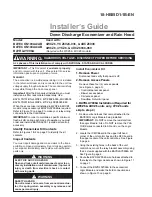
Mini Amazon III Series
118
Pressure gauge
4.9.2 Procedure
Notes for installers
During vacuum drying, a vacuum pump is used to lower the pressure in the piping to the extent that any moisture
present evaporates. At 5mmHg (755mmHg below typical atmospheric pressure) the boiling point of water is 0°C.
Therefore a vacuum pump capable of maintaining a pressure of -756mmHg or lower should be used. Using a vacuum
pump with a discharge in excess of 4L/s and a precision level of 0.02mmHg is recommended.
Caution
Before performing vacuum drying, make sure that all the outdoor unit stop valves are firmly closed.
Once the vacuum drying is complete and the vacuum pump is stopped, the low pressure in the piping could
suck vacuum pump lubricant into the air conditioning system. The same could happen if the vacuum pump stops
unexpectedly during the vacuum drying procedure. Mixing of pump lubricant with compressor oil could cause
compressor malfunction and a one-way valve should therefore be used to prevent vacuum pump lubricant
seeping into the piping system.
Procedure
The vacuum drying procedure is as follows:
Step 1
Connect the blue (low pressure side) hose of a pressure gauge to the outdoor unit gas pipe stop valve, the red
(high pressure side) hose to the outdoor unit liquid pipe stop valve and the yellow hose to the vacuum pump.
Step 2
Start the vacuum pump and then open the pressure gauge valves to start vacuum the system.
After 30 minutes, close the pressure gauge valves.
After a further 5 to 10 minutes check the pressure gauge. If the gauge has returned to zero, check for leakages in
the refrigerant piping.
Step 3
Re-open the pressure gauge valves and continue vacuum drying for at least 2 hours and until a pressure
difference of 756mmHg or more has been achieved. Once the pressure difference of at least 756mmHg has been
achieved, continue vacuum drying for 2 hours.
Step 4
Close the pressure gauge valves and then stop the vacuum pump.
After 1 hour, check the pressure gauge. If the pressure in the piping has not increased, the procedure is finished.
If the pressure has increased, check for leakages.
After vacuum drying,
keep the blue and red hoses connected to the pressure gauge and to the outdoor unit
stop valves
, in preparation for refrigerant charging (see Part 3, 7 “Charging Refrigerant”).
Figure 3-4.12: Vacuum drying
Summary of Contents for KMF-100 DVN4
Page 140: ......
















































